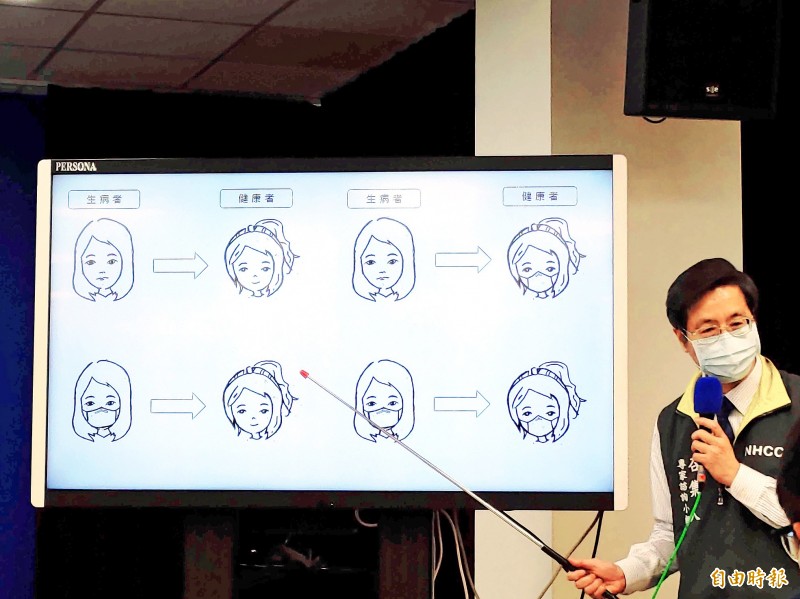《TAIPEI TIMES》Masks greatly limit spread: CECC

Central Epidemic Command Center specialist advisory panel convener Chang Shan-chwen speaks at a news conference in Taipei on Saturday. Photo: Wu Liang-yi, Taipei Times
PLAYING THE ODDS: A CECC official said that if healthy and infected people are wearing masks, their risk of viral transmission is reduced to about 1 to 2 percent
By Lee I-chia / Staff reporter
Wearing masks greatly reduces the risk of spreading COVID-19, Central Epidemic Command Center (CECC) specialist advisory panel convener Chang Shan-chwen (張上淳) said.
Chang made the remark at the center’s daily news conference on Saturday.
“Many people have asked why several confirmed cases in Taiwan did not spread the virus to other people,” Chang said, pointing to an illustration depicting a healthy person and an infected person interacting in possible scenarios.
He said that the risk of infection is high if both are not wearing masks, but if only the healthy person wears a mask, the risk of contracting COVID-19 through respiratory droplets is greatly reduced — possibly by as much as 50 to 80 percent.
If only the infected person wears a mask, the spread of the virus through droplets might be reduced by about 80 to 90 percent, with a risk of leakage from the sides of the mask, he said.
When both wear a mask, the risk of transmission is significantly reduced to about 1 to 2 percent, he added.
Discussing the eight cases reported at a hospital in February, Chang said that the infected person (the nation’s 34th confirmed case) had difficulty breathing, so she sometimes did not wear a mask, and might have contaminated the environment.
Chang also addressed the epidemiological characteristics of the nation’s suspected and confirmed cases — a total of 63,340 between Jan. 15 and Thursday last week.
Taiwan reported zero cases for six consecutive days ending on Friday, with three cases reported on Saturday.
“We issued travel warnings for many countries in mid-March and travelers returning from those countries with symptoms were reported upon arrival in Taiwan, so the numbers of daily reported suspected cases significantly increased from mid-March, and gradually reduced as very few travelers have arrived in the past few weeks,” he said.
The numbers of daily confirmed cases indicate a similar trend, showing that the peak of reported cases was in mid-March, he said.
Among the symptoms reported by the 429 infected people when they were tested, 51 percent reported coughing, 45 percent had a fever, 25 percent had a stuffy or runny nose, 17 percent had an abnormal sense of smell and 10 percent had an abnormal sense of taste, Chang said.
Doctors’ clinical diagnoses of the first 100 confirmed cases show that the two most common symptoms were fever and coughing, he said.
Of those cases, 54 percent had a fever, 54 percent were coughing, 35 percent had throat pain, 27 percent had stuffy or runny noses, 25 percent had fatigue, 14 percent had sore muscles, 10 percent had diarrhea, 10 percent had headaches, 10 percent had an abnormal sense of smell or taste, and 2 percent had nausea or were vomiting.
“Twenty-four people have used or are using ventilators as previously reported, including the six who died,” Chang said. “The number of people who are now on ventilators dropped from 10 to six this week, meaning that 12 people have been taken off a ventilator after recovery.”
Since April 20, the number of COVID-19 patients who have been discharged from hospitals after treatment exceeded those who are being hospitalized, he said.
In response to a question about why the number of cases confirmed on the navy supply ship Panshih (磐石) was lower than in similar incidents in other nations, he said that the people on board who had a fever were told to stay in the ship’s sick bay until their fever subsided and to wear a mask when they returned to their post.
“We don’t know if they conformed to the order to wear masks at all times, but if the infected people wore a mask, the healthy crew members wore a mask or if they all wore masks at least some of the time, the risk of viral transmission would still be significantly reduced,” Chang said.
新聞來源:TAIPEI TIMES
















